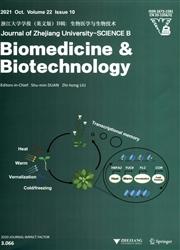褐飞虱(Nilaparvata lugens, st l)背囊类元件的功能特征(半翅目:飞虱科)
IF 4.9
3区 生物学
Q1 BIOCHEMISTRY & MOLECULAR BIOLOGY
引用次数: 1
摘要
PiggyBac是一种转座DNA元件,最初在白菜环蛾(Trichoplusia ni)中发现。T. ni piggyBac转座子可以将外源片段引入基因组,构建转基因生物。然而,在使用piggyBac之前,对内源的piggyBac样元件(PLEs)进行综合分析是很重要的,因为它们可能会影响转基因品系的遗传稳定性。本文对褐飞虱(BPH) Nilaparvata lugens (stapul)(半翅目:飞虱科)的全基因组序列进行了分析,共鉴定出28个PLE序列。所有lugens piggyback -like元件(NlPLEs)在BPH基因组中以多拷贝形式存在。在所鉴定的nlple中,NlPLE25拷贝数最高,分布在5条染色体上。NlPLE25全长包括末端倒置重复序列和两端亚末端倒置重复序列,以及一个编码546个氨基酸的开放阅读框转座酶。此外,NlPLE25转座酶在培养的昆虫细胞中实现了精确的切除和转座,并在切除后恢复了原始的TTAA靶序列。该研究还揭示了NlPLE25转座子和piggyBac转座子之间的交叉识别。这些发现为构建转基因昆虫品系提供了有益的信息。本文章由计算机程序翻译,如有差异,请以英文原文为准。
Functional characterization of piggyBac-like elements from Nilaparvata lugens (Stål) (Hemiptera: Delphacidae)
PiggyBac is a transposable DNA element originally discovered in the cabbage looper moth (Trichoplusia ni). The T. ni piggyBac transposon can introduce exogenous fragments into a genome, constructing a transgenic organism. Nevertheless, the comprehensive analysis of endogenous piggyBac-like elements (PLEs) is important before using piggyBac, because they may influence the genetic stability of transgenic lines. Herein, we conducted a genome-wide analysis of PLEs in the brown planthopper (BPH) Nilaparvata lugens (Stål) (Hemiptera: Delphacidae), and identified a total of 28 PLE sequences. All N. lugens piggyBac-like elements (NlPLEs) were present as multiple copies in the genome of BPH. Among the identified NlPLEs, NlPLE25 had the highest copy number and it was distributed on five chromosomes. The full length of NlPLE25 consisted of terminal inverted repeats and sub-terminal inverted repeats at both terminals, as well as a single open reading frame transposase encoding 546 amino acids. Furthermore, NlPLE25 transposase caused precise excision and transposition in cultured insect cells and also restored the original TTAA target sequence after excision. A cross-recognition between the NlPLE25 transposon and the piggyBac transposon was also revealed in this study. These findings provide useful information for the construction of transgenic insect lines.
求助全文
通过发布文献求助,成功后即可免费获取论文全文。
去求助
来源期刊

Journal of Zhejiang University SCIENCE B
生物-生化与分子生物学
CiteScore
8.70
自引率
13.70%
发文量
2125
审稿时长
3.0 months
期刊介绍:
Journal of Zheijang University SCIENCE B - Biomedicine & Biotechnology is an international journal that aims to present the latest development and achievements in scientific research in China and abroad to the world’s scientific community.
JZUS-B covers research in Biomedicine and Biotechnology and Biochemistry and topics related to life science subjects, such as Plant and Animal Sciences, Environment and Resource etc.
 求助内容:
求助内容: 应助结果提醒方式:
应助结果提醒方式:


